

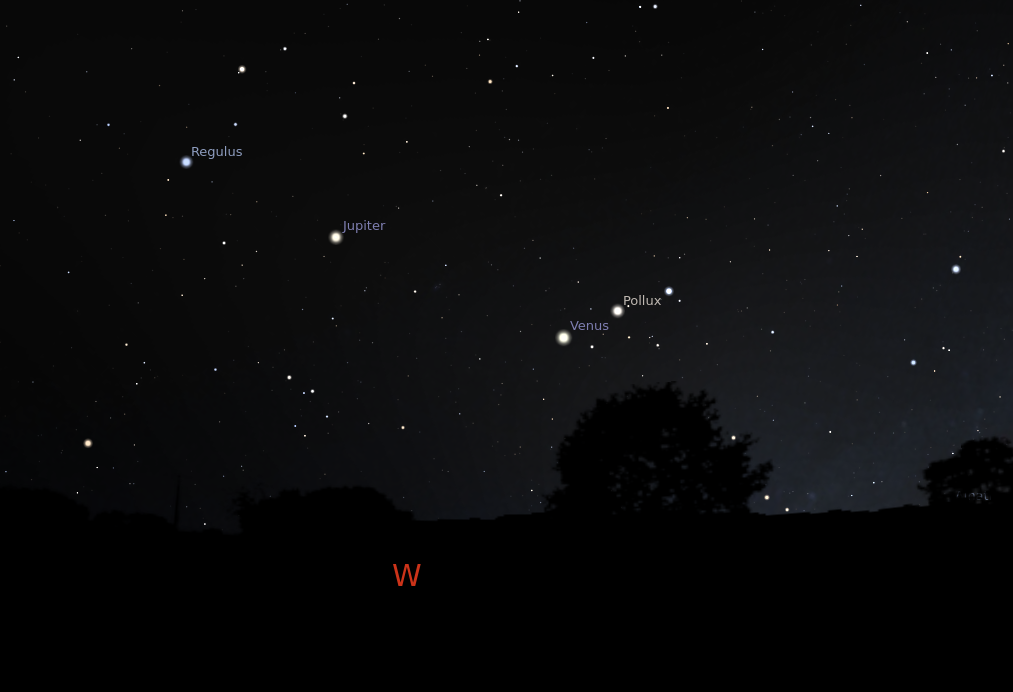
All this month (June 2015) Venus and Jupiter will be moving closer and closer together in the night sky.
Venus and Jupiter appear to be on a collision course in the sky. They are of course not going to collide as they orbit the Sun on opposite sides of the Earth's orbit.
Venus orbits the Sun at 108,200,000 km and Jupiter at 778,500,000 km, a gap of approximately 670,300,000 km.
However when viewed from Earth during this month, they will appear to be on a collision course. They will reach their closest point on Tuesday 30th June. There will be less than 1° of difference!!!
You will be able to watch them in the sky even before sunset because they are two of the brightest objects in the sky apart from the Moon and the Sun.
At 10pm on the 1st of June they will be 21° apart, by the 5th of June this will have reduced to 17°, on the 10th June the gap will be 13° and on the 15th June only 9° apart.
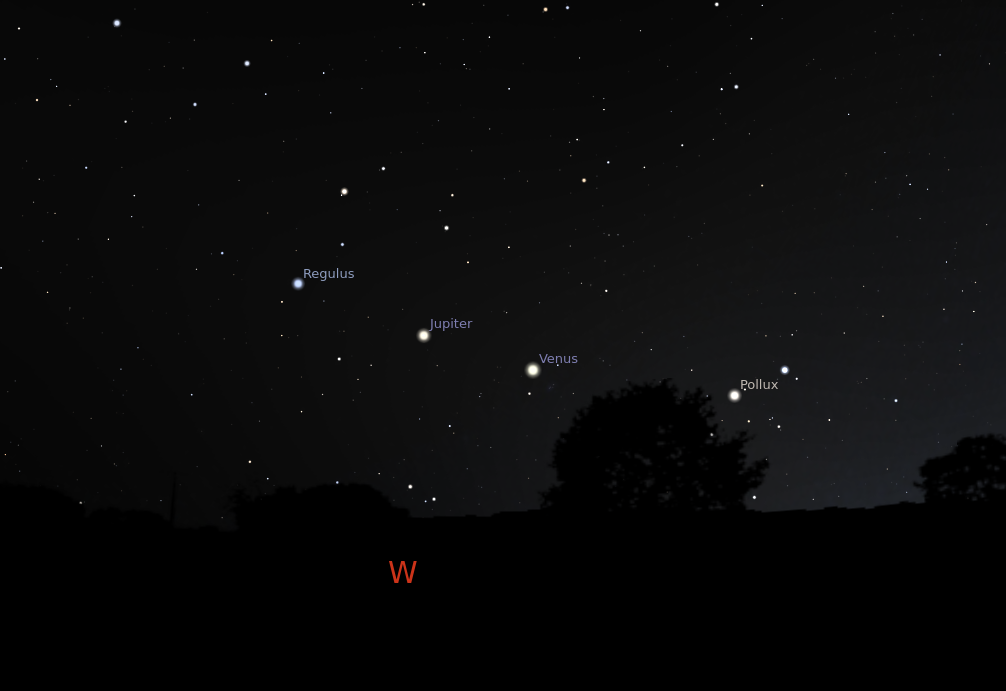
In the next 15 days this gap will shrink to well under 1°.
As the planets align this gap will shrink to well under 1°. At their closest you will be able to see both planets at the same time with binoculars or a small telescope.
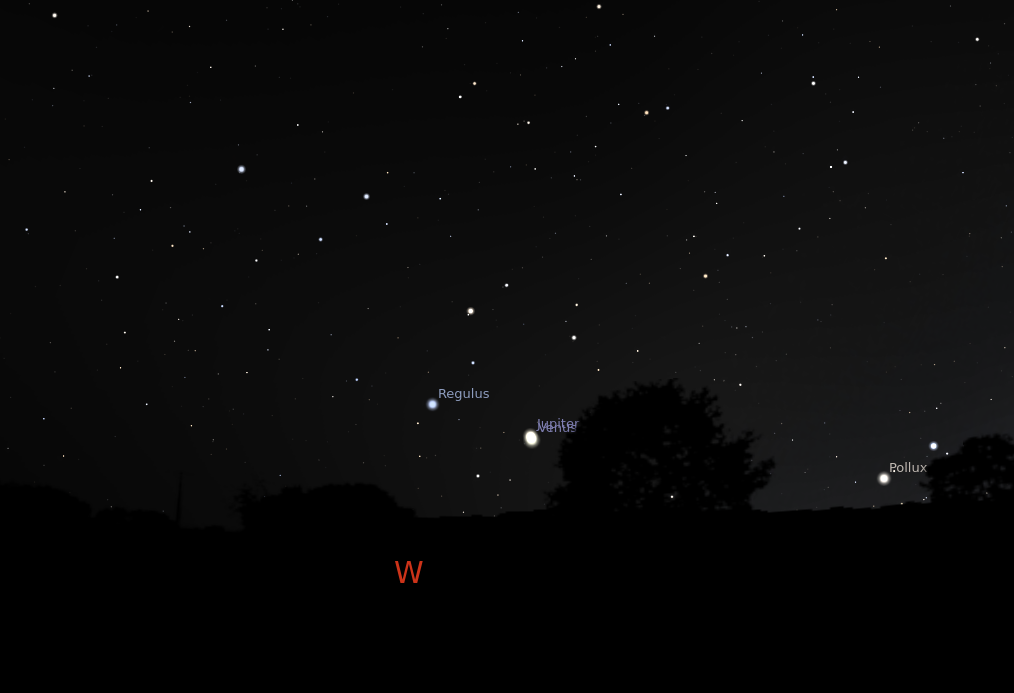
Here is an animation of the movement of Venus and Jupiter on the 1st, 5th, 10th, 15th, 20th, 25th, 26th, 27th, 28th, 29th, and 30th of June.
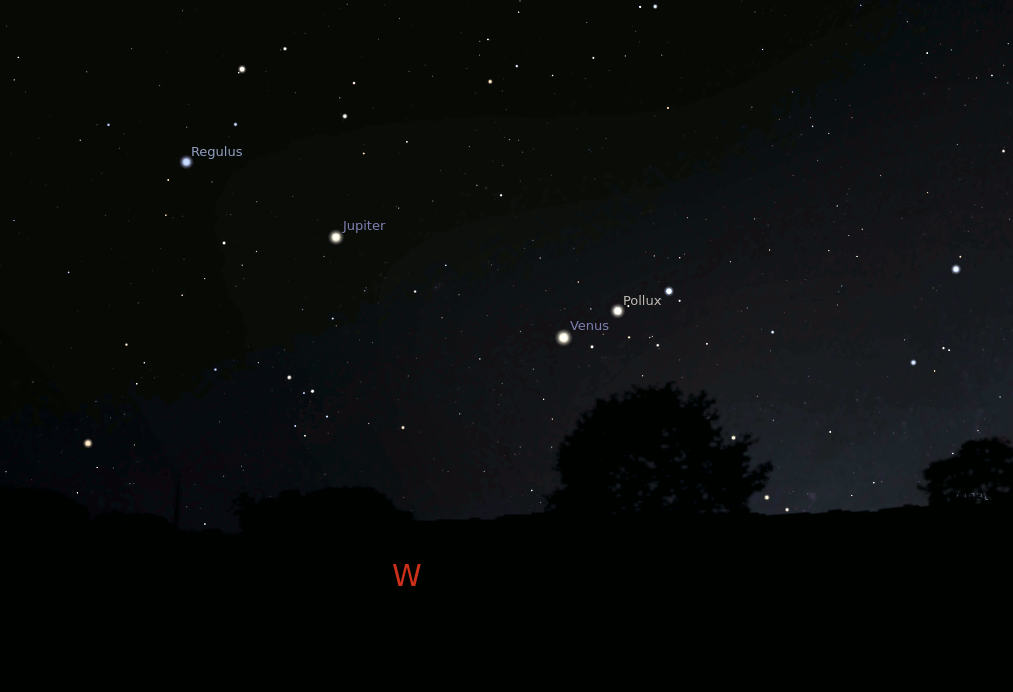
We hope you can all watch this spectacular event over the course of the month.
--------------------------------------------------------------------------------------------------------------
The "JAC & Gill Club" were given a unique chance to experience what it might be like to be real astronauts for an afternoon, thanks to Spacefund and the West Bay Cafe both providing their services for FREE !
The children were treated to an inspiring performance of "Kids in Space" by Jo and Matt Fox, whose theatre company was funded by the UK Space Agency to perform for Thanet Astronomy Group. The show was opened by Thanet Astronomy Group's celebrity member, Juliette Kaplan, who is currently starring in Coronation Street as Agnes Tinker, but probably better known as Pearl in the ever popular Last of the Summer Wine.
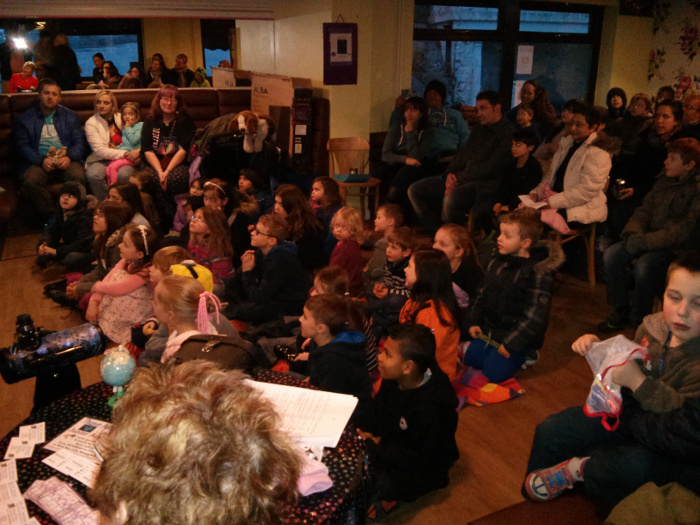
Over 40 enthusiastic children and their equally enthusiastic parents, were enrolled as crew members on a space rocket journey around the Solar System. Along with Captain Jo and Astronaut Matt, they embarked on a spectacular 50 minute voyage around the planets taking in the sights along the way, including a dramatic bombardment (literally) of asteroids as they reached the Asteroid Belt.
Astronaut Matt followed Neil Armstrong's first steps on the Moon combined with fascinating footage of Astronauts floating inside the Space Station. We then visited beautiful built-to-scale model planets to compare the sizes of our nearest neighbours Mercury, Venus and Mars. Then we came face to face with the giant scale models of Jupiter, Saturn, Uranus and Neptune!
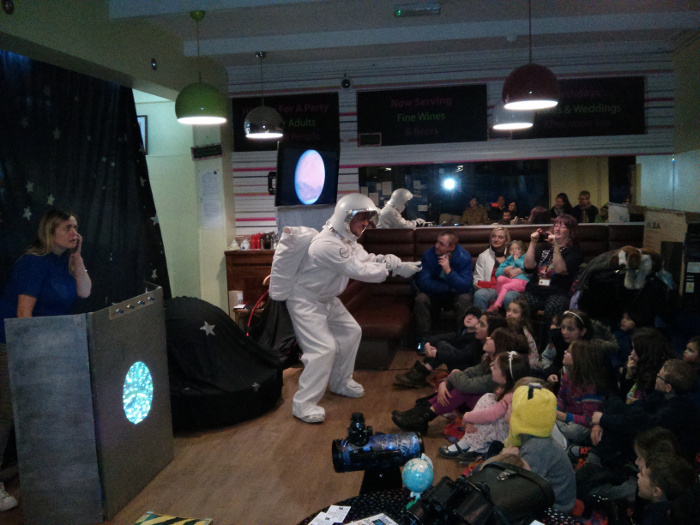
For the culmination of our afternoon, the children had the opportunity to "hold" the scale model planets in their hands on our journey back to the Sun. Astronaut Matt pointed out that he could not bring the scale model of the Sun as it would be the size of a hot air balloon.
If you or your children are interested in learning more about this fascinating subject of Astronomy, then please join us at one of our Free pop in Meetings at West Bay Cafe, Sea Road, Westgate-on-Sea. CT88QZ Any time between 1 and 4pm Every Saturday.
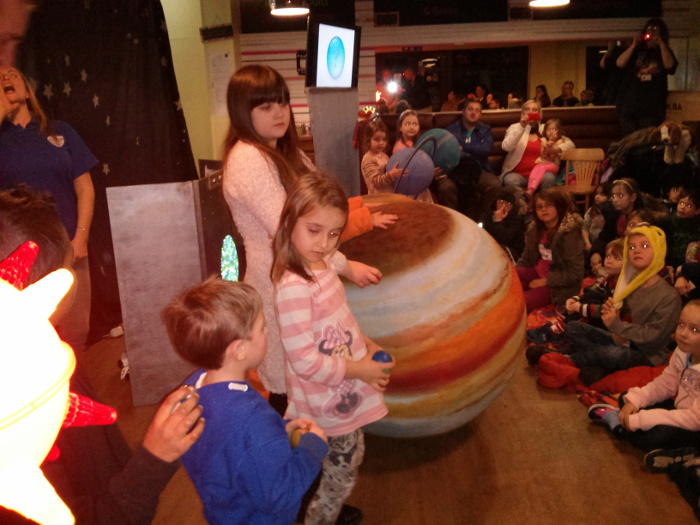
--------------------------------------------------------------------------------------------------------------
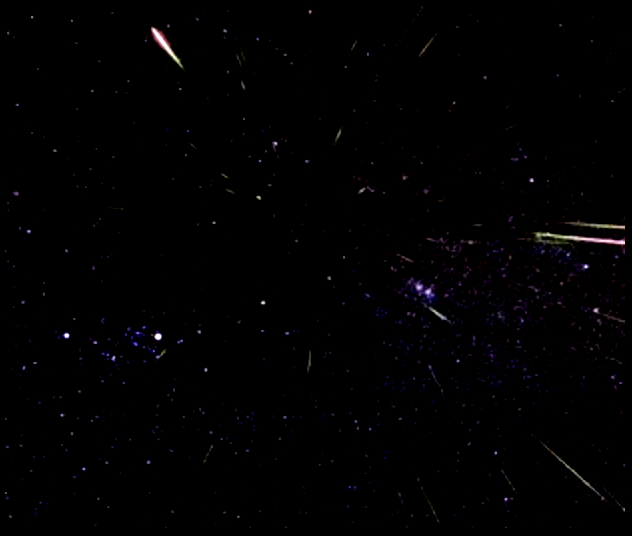
It is not easy to determine the best night because you have to take cloud cover and the slightly unpredictable nature of meteor showers into account.
The Geminid Meteor Shower can be seen this year (2014) as early as 7th December and as late as 16th December but it peaks this year on the night of the 13/14th December.
On the peak night 13/14th December it is predicted that there could be up to 120 meteors per hour.
Despite the peak day being the 13/14th, you will still see many meteors on the nights of the 11/12th, and 15/16th December. To give your self the best chance taking the weather into account start looking early if the sky is clear!!!
You don't need any Binoculars or Telescopes to see a meteor shower. If you attempt to use a Telescope or Binoculars you will be most unlikely to see anything at all. Just look towards the East after dark. Be as aware of as much sky as you can, the meteors can appear anywhere in the sky, above or beside you, so look all over.
Having said 120, you cant be looking everywhere at once so its a game of luck. You have to be looking at the right spot at the right second to see one. Unless you are looking directly at one when it appears, you are most likely to catch a flash of light shoot across the sky in the corner of your eye and wonder if you saw anything at all. If this happens you have most likely seen one ! So just keep looking until you just happen to be looking in the right place at the right time.
The meteors appear as a short streak or line of light in the sky. If you follow any of the lines back in the direction it came from, all the lines will converge on the same point in the sky, this point is called the 'Radiant' and will be in the constellation of Gemini, this is why this meteor shower is called the Geminid Meteor Shower.
You can see the Radiant marked by a white + in the left hand edge of the picture below. Remember this is the point the meteors radiate from. Do not look directly at this point, just look in this general direction i.e. Look East.
If you are lucky you may see a fireball. This is a larger meteor that during its passage through the Earth's atmosphere, the heat produced by friction causes the meteor to break up into lots of smaller parts, which look like an exploding fireball.
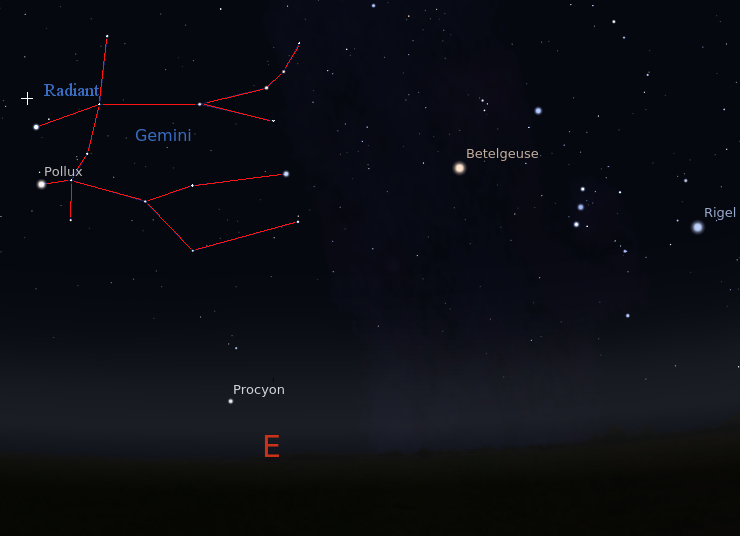
The Geminid meteor shower is not like most other meteor showers. Most meteor showers are caused by the Earth passing through a cloud of Meteoroids (dust and small rocks) in space left behind by a passing comet.
In the case of the Geminids its the dust and rocks left behind by a passing asteroid, 3200 Phaeton. The only other meteor shower known to be caused by an asteroid is the Quadrantids.
This debris from the passing asteroid spreads out into space and is left behind as the asteroid continues on its orbit.
When the Earth passes through the cloud of debris (called Meteoroids) some of the individual particles collide with the Earth's atmosphere and the heat caused by friction with the atmosphere vaporises them. It is the light given off as the meteor vaporises, that we see as the meteors or shooting stars.
Some times a meteor will not completely vaporise and it will reach the ground, It then is called a Meteorite.
--------------------------------------------------------------------------------------------------------------
Back in September 2013 while enjoying a pleasant afternoon meal at the West Bay Cafe. We were chatting to the owner about astronomy and that we were looking for a new venue. Alan very kindly suggested that we could use the cafe as a venue. We, of course, accepted this offer immediately. We were very lucky to have such an offer. There are not many astronomy groups that have the facilities we have at the West Bay Cafe.
Thanet Astronomy Group's first presentation at West Bay Cafe was on 21st September 2013. It was a very sociable event with a talk and slides on the subject of Jupiter and its Moons, followed by a roast evening meal. The Event was a huge success and marked the start of Thanet Astronomy Group at West Bay Cafe
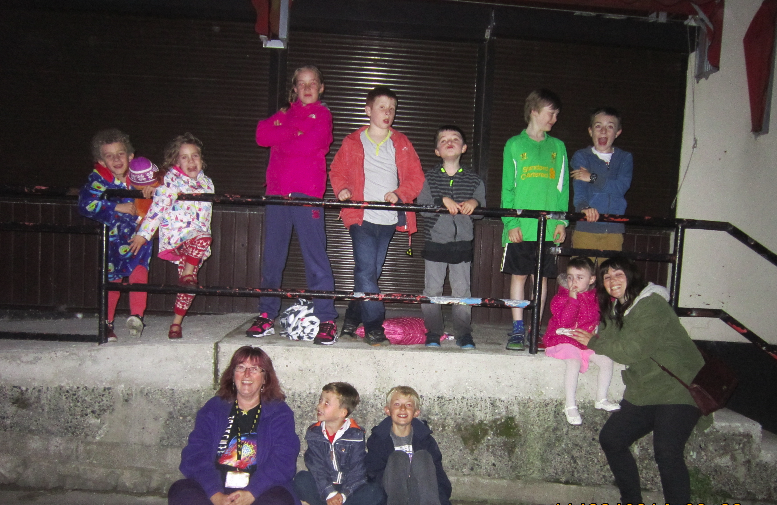
Since then we have run many Presentations, Courses, Star viewing evenings, an Astronomy Quiz and weekly public meetings designed to help people with an interest in astronomy overcome the first steps in this amazing hobby.
Thanet Astronomy Group Members Celebrated One Year at West Bay Cafe at the September Members Meeting with a buffet and social evening.
--------------------------------------------------------------------------------------------------------------

The Perseid Meteor Shower can be seen this year as early as 23rd June and as late as 20th August but it peaks this year on the 12th August. On the peak day 12th August it is predicted that there could be 100+ meteors per hour.
Despite the peak day being the 12th, you will still see many meteors on the nights of the 10th, 11th, 13th and 14th August. So if the weather is bad on the 12th don't give up just try another night. I have been seeing a few meteors nightly since late July, when the sky has been clear.
You don't need any Binoculars or Telescopes to see the meteor shower in fact you would be most unlikely to see any while using a Telescope or Binoculars. Just put the moon (that is in the East) on your right hand side and look straight ahead (to the North). Then try to be aware of as much sky as you can, the meteors can appear anywhere in the sky in front, above or beside of you, so look all over.
Unless you are looking directly at one when it appears, you are most likely to catch a flash of light and wonder if you saw anything at all. So just keep looking until you just happen to be looking in the right place at the right time.
The meteors appear as a short streak or line of light in the sky. If you follow the line back in the direction it came from then all the lines will converge on the same point in the sky, this point will be the constellation Perseus and this is why this meteor shower is called the Perseid Meteor Shower.
If you are lucky you may see a fireball. This is a larger meteor that during its passage through the Earth's atmosphere, the heat produced by friction with the atmosphere causes the meteor to break up into lots of smaller parts, which look like an exploding fireball.
It is a shame this year that we also have a nearly full moon in the east (full moon 10th Aug) that will drowned out the light from most of the lesser meteors but there will be plenty of brighter ones and hopefully some fireballs that will be visible.
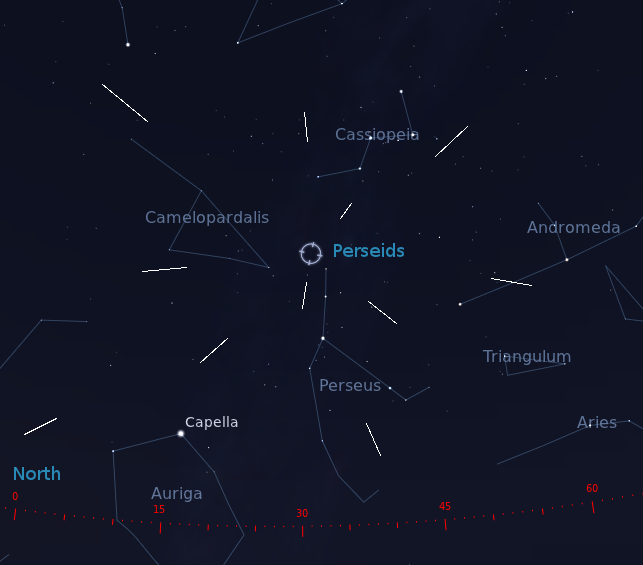
The Perseid meteors like many other meteor showers are caused by the Earth passing through a cloud of small Meteoroids in space.
These clouds or trails are formed by comets that orignate from the Oort Cloud and get disturbed from their position in the Oort Cloud and end up in an orbit around the Sun.
A comet is like a dirty snowball. Imagine you mixed up some coal dust and snow and squeezed it into a very hard snowball. As a comet passes near to the Sun it begins to warm up. The ice begins to melt into water and then evaporate, this releases the dust and particles trapped within. This is what you see when looking at the beautiful tails some comets produce.
This debris from the melting comet spreads out into space and is left behind as the comet continues on its orbit.
When the Earth passes through the cloud of debris (called Meteoroids) some of the individual particals collide with the atmosphere and the heat caused by friction with the atmosphere vaporises them. It is the light given off as the meteor vaporises, that we see as the meteors or shooting stars.
Some times a meteor will not completely vaporise and it will reach the ground, It then is called a Meteorite.
--------------------------------------------------------------------------------------------------------------
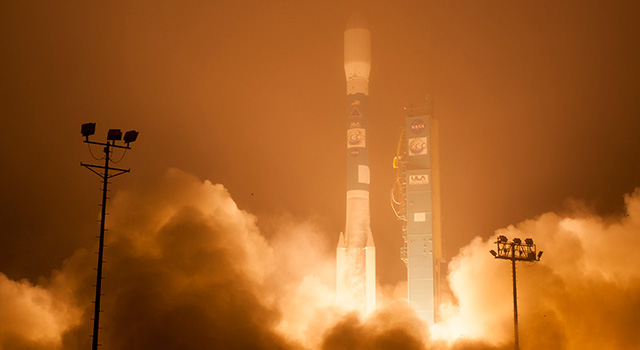
See the Youtube video of the launch.
The OSO-2 Lifts Off on top of a Delta II rocket from California's Vandenberg Air Force Base. The successful launch was at 2:56am Pacific Time July 2nd 2014.
Both stages of the Delta II rocket and the fairing covering the OCO-2 have successfully separated.
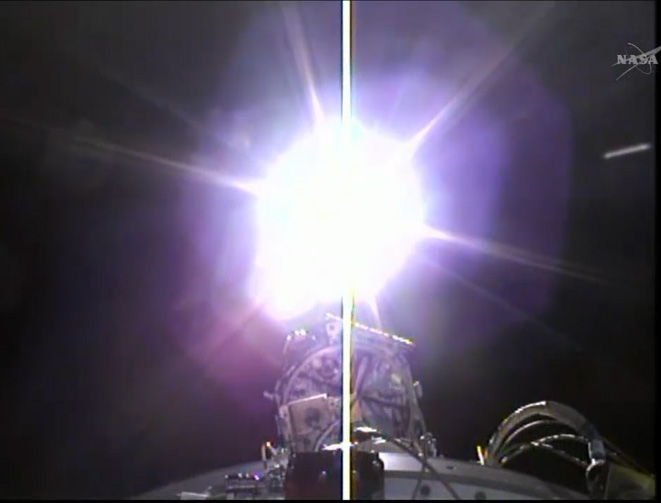
The solar panels used to power the OCO-2 have opened, allowing the engineers to establish communication with the observatory.
It will now take about 45 days to complete the remaining operations to move the OCO-2 into its final orbital position and start the mapping of the worlds Carbon Dioxide Levels.
--------------------------------------------------------------------------------------------------------------
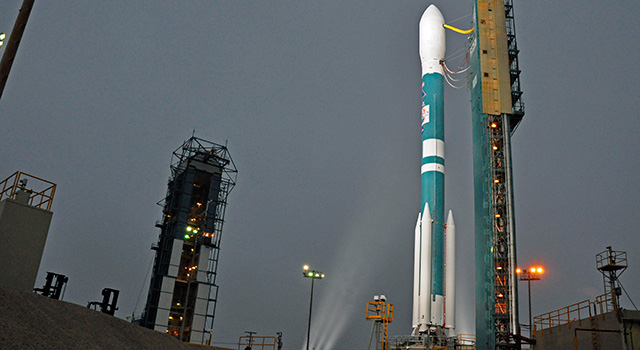
Following the scrubbed launch the 'Orbiting Carbon Observatory-2' earlier today. The launch team has completed the inspection of the launch pad water suppression system and the valve that failed during the launch has been replaced. The system is now being tested ready for the second launch attempt on 2nd July.
The weather forecast for the 2nd July launch is showing a 100% chance of good conditions for the lift-off, which is set for 5:56:23 EDT.
--------------------------------------------------------------------------------------------------------------
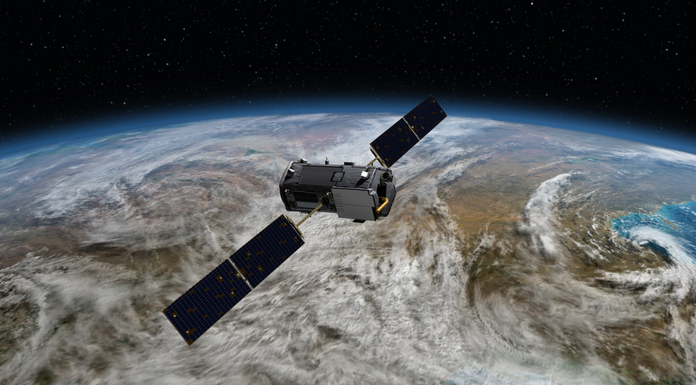
The launch the the 'Orbiting Carbon Observatory-2' from California's Vandenberg Air Force Base launch complex 2 has been scrubbed at T-46 seconds. The OCO-2 launch was scrubbed during the last few seconds due to a failure in the launch pad water system. This water system is used to protect the launch pad flame duct from the heat produced by the Delta II rocket. It also helps to suppress the noise from the rocket engine.
Both the OCO-2 and the Delta II rocket are in a safe configuration. According to Tim Dunn the NASA Launch Manager for today's countdown, the task now will be to offload the liquid Oxygen then the RP1 from the first stage of the Delta II rocket. Then the Mobile service tower will be brought back around the rocket which will take several hours. Once all the systems are in a safe configuration the managers and engineers will be able to access the launch pad to inspect and evaluate the fault.
The plan is to protect the possibility of a 24 hour recycle of the launch but this depends on what it found during the inspection. The second option would be a 48 hour recycle if the repair is more difficult.
RP1 Rocket Fuel is a super refined form of Kerosene. It has a lower specific impulse (less power) than liquid hydrogen, but is much cheaper, stable at room temperature, far less of an explosion risk and less toxic.
--------------------------------------------------------------------------------------------------------------
At about 03:04pm UK BST 30th June 2014 a fireball or 'bolide' meteor was seen over Devon in the West Country, Wales and West Midlands.
The fireball was reported to be bright enough to cast shadows and green in colour.
The International Astronomical Union has no official definition for the term 'Bolide' but it is generally excepted to mean a meteor in the process of burning up due to friction with the Earth's atmosphere, resulting in a bright 'fireball' (a magnitude of -14 or more). It is also used to mean any generic large crater-forming meteoroid or asteroid whose composition is unknown.
The BBC reported that the Norman Lockyer Observatory meteor watch / sky cam had recorded the fireball as it broke up and burnt out in the atmosphere today.
See the video by clicking Here.

--------------------------------------------------------------------------------------------------------------
You can click on the link to open the :- OCO-2 article as a PDF file. You will then be able to save it or print it out.

On July 1st 2014 NASA will launch the the 'Orbiting Carbon Observatory-2' from California's Vandenberg Air Force Base. The OCO-2 replaces the 'OCO', which crashed at launch on 24 February 2009. This satellite will be the first Earth remote sensing satellite dedicated to monitoring the concentration of CO2 in our atmosphere.
The erratic and severe swings in the Earth's weather are becoming more pronounced. Carbon Dioxide or CO2 is one of the green house gases responsible for global warming. The data from OCO-2 will help scientists to better understand and repair the damage done.
This Satellite will orbit the Earth in a polar orbit at a height of 705 Km above the Earth. It will pass over both north and south poles every 99 minutes. Each orbit of this satellite will pass over a different section of the Earth. After 233 orbits, having covered the entire Earth's surface in 16 days, the pattern will start again.
The Satellite will make about 16,000,000 measurements every 16 days and is planed to continue for at least two years but is expected to continue well past this, To make these measurements the OCO-2 has three spectrometers that can look at an area of the Earth's surface as small as 3 square kilometres.
The OCO-2 does not measure CO2 directly but uses the spectrometers to measure the suns light that is reflected from the Earth's surface. This light is split into its separate colours (just like a rainbow). As CO2 absorbs specific colours of light, NASA can detect the CO2 levels from the missing colours in this reflected light. This Satellite will be able to measure the CO2 levels everywhere on Earth every 16 days.
Here is a link to the count down at NASA JPL Count Down page for details
--------------------------------------------------------------------------------------------------------------

On Thursday 27th February 2014 people began reporting seeing the Aurora Borealis (The Northern Lights) as far south as Thanet.
I will explain below what causes the Aurora Borealis and why it was seen so far south last night.
There are many historical beliefs about the Aurora, but here are just a couple.
The Inuit believe that the spirits of their ancestors can be seen dancing in the shimmering coloured lights that ripple across the sky.
According to Norse mythology the Aurora is a bridge of fire leading to the sky built by their Gods.
There are two sets of 'lights' the Aurora Borealis (Northern Lights) and the Aurora Australis (Southern Lights). These both have the same causes and look similar. The difference being that the Northern Lights are found at the North Pole, and the Southern Lights at the South Pole.
When you see the Aurora Borealis or Aurora Australis you are seeing many small particles of light called photons. These are caused by high energy particles ejected by the Sun (our nearest Star) hitting the gases in the Earth's atmosphere.
When these high energy particles from the Sun, strike the atoms of the gases in the Earth's atmosphere they add a little energy to the gas atoms and one of the Electrons in orbit around the centre of the atom of gas is bumped into a higher level orbit than it was in before the collision took place.
This is like when you play "swing ball". When the ball is hit by the bat, it takes on some extra energy and starts flying around faster and moves up in angle so that it can fly a little further away from the post.
This higher orbit is not where the Electron should be, it wants to settle back to where it was, but it has to lose the extra energy it got from the collision to be able to do this. The way this works is that the energy is given off from the Electron in the form of one Photon (a particle of Light). Then the Electron returns to its normal place.
So its these Photons of light, caused by the collisions, that you see when looking at the Aurora Borealis or Aurora Australis.
The colours are caused by the different gases in the atmosphere. The most common Aurora is green and this is caused by the solar particles hitting Oxygen at about 60 miles above the earth. Oxygen at about 200 miles up causes the red Aurora. There are other colours that can be seen, such as blue caused by Ionic Nitrogen or a reddish purple caused by neutral Nitrogen.
This effect is like the more familiar neon lights we see in street adverts. The same process is happening in both. Charged particles are colliding with the gases in the neon tubes and cause them to give off light (Photons). Different Gases cause different colours.
Coronal Mass Ejections or CME's. These are where huge amounts of matter and electromagnetic radiation is ejected from the Sun into inter planetary space. The ejected material is in the form of plasma mainly consisting of electrons and protons. These are the particles that strike the gases in the Earth's atmosphere and cause the Aurora.
A phenomenon called Magnetic Reconnection is the cause of CME's. The Coronal Mass Ejection is released when two oppositely directed magnetic fields are brought together. The resulting rearrangement of the magnetic fields is accompanied by the release of energy stored in the oppositely directed fields and this release of energy ejects the matter present.
On Monday 24 Feb at 7:49 EST, NASA's Solar Dynamics Observatory spotted a major solar flare. This was the most powerful solar eruption this year and one of the biggest in recent years. This massive flare was X4.9-class. The flair came from an active sun spot called AR1990. The NASA Space craft captured a high definition video of the solar flare erupting from the Sun along with a giant burst of Plasma, the Coronal Mass Ejection !
Solar flares are classified in 5 groups, A, B,C, M and X. Each of these groups are sub divided into a logarithmic scale from 1 to 9. So you have A1 to A9 then B1 to B9 and so on through to X1 on. The X category does not stop at 9. X Class is the highest category and each X number is twice the one before. The Solar flare classes could be thought of in a similar way as the Richter scale for earth quakes.
This CME was not aimed directly towards Earth (only some are) so we knew it would not cause much damage. It was travelling at about 4.4 Million Miles per Hour, so took a while to cover the 90 million plus miles to Earth. When it reached Earth our magnetic field deflected most of its matter safely away from Earth , but at the poles where the magnetic field line channel down to the surface the particles are drawn in and follow the field lines. Therefore some of the particles reach the gases in our atmosphere and cause the Aurora. This was an extremely large ejection so the Aurora covered a larger area and was brighter than usual and, combined with the calm and clear air conditions and very little cloud, we were able to see this exceptional sight.